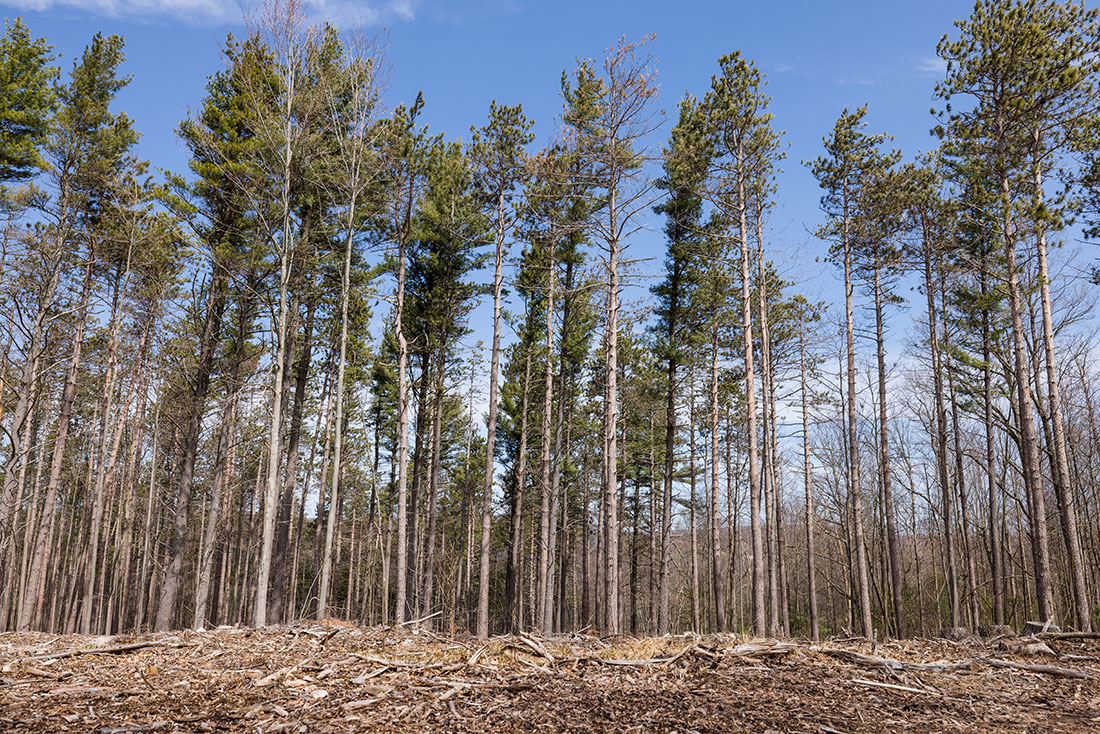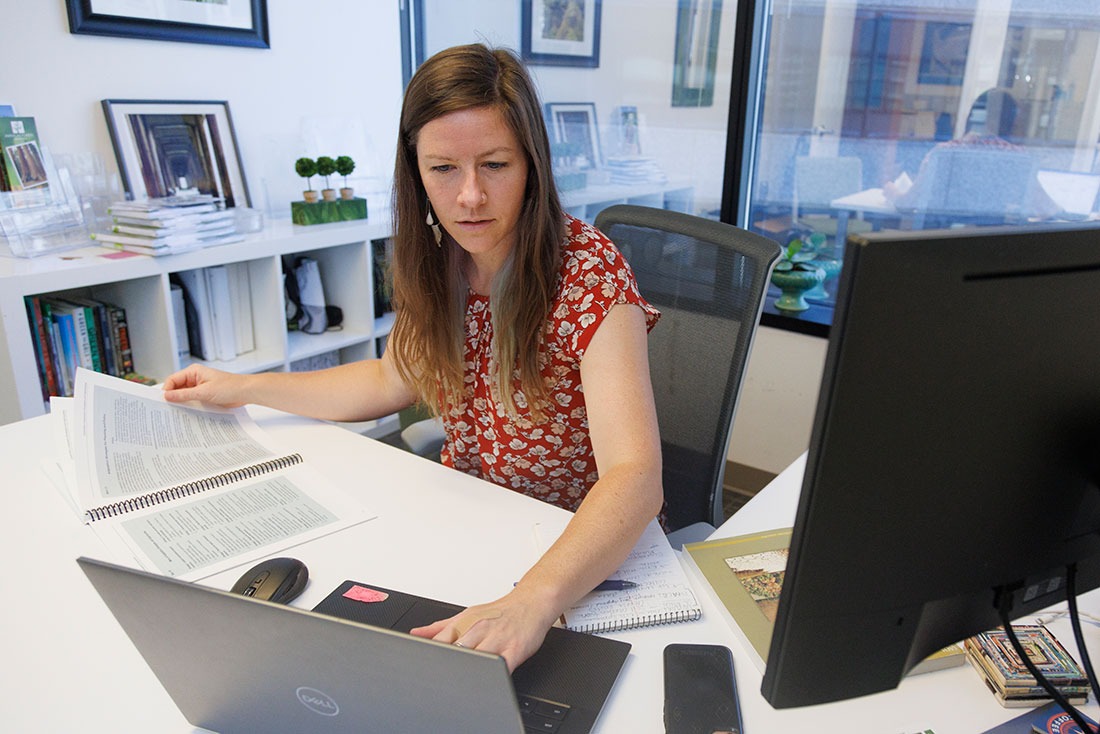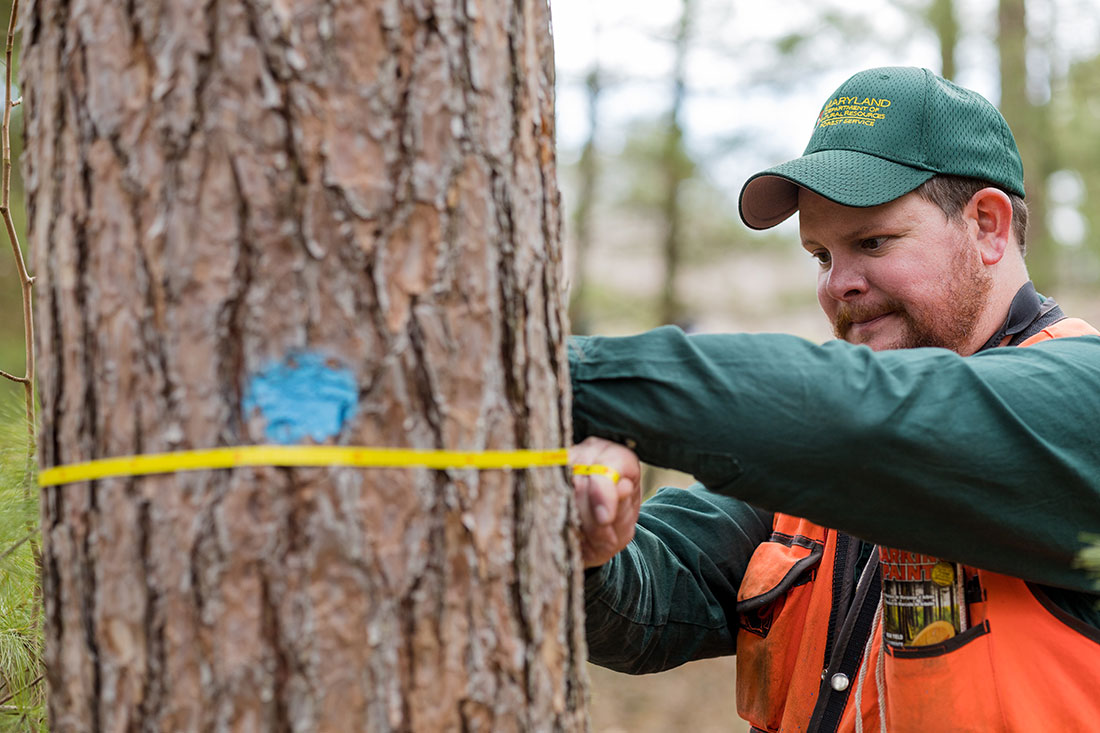ON A CRISP SPRING MORNING in Savage River State Forest in western Maryland, Sean Nolan and Kendall DeLyser are standing underneath towering pines in the Blocher Cemetery conifer stand, looking at satellite images of the forest. These 23 acres of spruce trees and red and white pine were thinned in 2021 and 2022, with the wood destined for split-rail fencing and paper mills.

Photo Credit: Taylor Kampia / American Forests
Nolan is here in his role as the Savage River State Forest manager. This is one of dozens of areas he oversees in this 55,000-acre state forest tucked away in the uppermost corner of Maryland close to Pennsylvania and West Virginia.
But DeLyser, American Forests’ director of climate science, is on a different mission. She’s here to get an up-close look at a passion project she’s worked on for three years: a massive multi-state modeling project designed to analyze the carbon storage potential of various forest management and wood use strategies.
“Forests have to be part of a climate solution,” DeLyser says. “They’re not the only solution — we can’t get to all of our emissions-reduction goals on the back of forests alone — but we can’t get there without them.” — KENDALL DELYSER, DIRECTOR OF CLIMATE SCIENCE, AMERICAN FORESTS
As trees grow, they pull carbon out of the atmosphere through photosynthesis, locking most of it away in their trunks, branches and roots. Anything that absorbs carbon, such as trees, soil or plants, is known as a carbon sink. And trees, in particular, can be powerful carbon sinks if they are well managed.
DeLyser’s goal is for states to use the data from her models to protect forests from future climate impacts, help forest landowners implement climate-smart and financially beneficial practices, and inform forest management and policy. The project is funded by the U.S. Climate Alliance and led by American Forests in partnership with the Northern Institute of Applied Climate Science, the U.S. Forest Service, the Canadian Forest Service, and Michigan State University’s Forest Carbon and Climate Program.
DeLyser and her team delivered reports on this topic to officials in Maryland and Pennsylvania in December 2022. The reports provide powerful data to make the case for various climate-smart forest management practices. For instance, land managers can maintain and increase forest extent by reducing deforestation or by adding more trees to the landscape (afforestation) or on livestock pasture (silvopasture). They can help forests regenerate naturally by controlling deer browse (eating the leaves, buds and twigs of woody plants such as shrubs) and restocking understocked tree stands. And they can boost sustainable management by reducing “high grading,” a practice that culls only the largest, most valuable trees, leaving only small, stunted trees with limited carbon storage potential. Finally, the report notes that longer rotations between tree harvests optimize forest growth and recommends that states prepare for the negative impacts of climate change, especially from increasing pests and diseases.

Photo Credit: Bryan Dozier / American Forests
DeLyser and her team found that by implementing these practices concurrently, Maryland can increase the carbon its forests capture and store annually by 29% by 2030 and by 68% by 2100. For Pennsylvania, those numbers are 38% and 124%, respectively. Currently, however, Pennsylvania’s aging forests are losing their ability to capture carbon, meaning the state is moving from being a carbon sink to a carbon source, highlighting why the data in the reports is crucial for long-term management decisions.
The team’s models also consider how much carbon remains in wood products after they are harvested and how that compares to the climate impact of building materials, such as steel, that require a lot of energy to produce.
“Good forest management is good carbon management in my book,” says Shawn Lehman, program manager for the Pennsylvania Bureau of Forestry’s resource inventory monitoring section. Pennsylvania is a vast state with a $37 billion forest products inventory, so Lehman says a portfolio of forest management practices is essential. “From my perspective, there’s not one single management strategy that’s the silver bullet. It’s about maintaining forest health and the productivity of our forests, and managing them on a scientific basis.”
The reports aim to help fix a major stumbling block to states achieving their climate goals: a lack of solid data about how various forest and land management practices impact carbon storage potential. Maryland’s Greenhouse Gas Reduction Act requires the state to reduce greenhouse gas emissions 50% by 2030, and in late 2022 the state announced a plan to plant 5 million native trees by 2030. DeLyser hopes that the data her team provides will shed light on whether this is the most effective way for the state to meet its climate goals, and whether it’s enough.
“We’ve been working closely with our partners in Maryland and Pennsylvania to understand the things that they’re most concerned about with the forest management practices they might use in the future,” DeLyser says. “And then we run that through a carbon model so we can understand how those different practices might influence carbon storage.”
In Savage River State Forest, Nolan and his team thinned the densely packed conifers at the Blocher Cemetery to improve the growth rate and diversity of trees, many of which were dying. This practice encourages young trees including hardwoods to grow, which is good for the forest. And what’s good for the forest is also good for the climate.

Photo Credit: Taylor Kampia / American Forests
“A healthier tree growing faster is going to capture more carbon than a slow growing tree — or much worse, a standing dead tree,” Nolan says. Anne Hairston-Strang, Maryland’s acting state forester, sees the older trees in a forest as the bonds in a stock portfolio, while the younger trees are like growth stocks.
“This is the way we regenerate the next faster growing stages of carbon,” she says. “You want to keep some of your bonds, but you need to have some in those growth stocks and some of the mixed stocks in the middle. So, where we are actively managing the forest for different ages and a variety of hardwoods and pines, we’re building that diversity within the stand and across the landscape.”
The report also analyzes silvopasture, a management practice that integrates trees into pasture land without taking the land away from pastoral use. This practice is beneficial to livestock, providing them shade and additional food sources from leaves. The trees can also be a source of income from timber, nuts or carbon credits sold to companies that want to offset their emissions. Maryland and Pennsylvania have a lot of pastureland, translating into thousands of acres of potential planting sites.

Photo Credit: Trees for Graziers
“I think it’s a win-win,” DeLyser says. “It’s not like we’re putting trees in places that they don’t survive. We’re just reintegrating those trees into the landscape in a way that they can survive and contribute to the health of the ecosystem.”
Hairston-Strang, for her part, has already begun working with colleagues in the state to incorporate the carbon modeling into their accounting on greenhouse gas reduction.
“This gives us so much better data,” she says. “It gives us the ability to look over 100 years, as well as across our whole landscape.”

Photo Credit: Taylor Kampia / American Forests
DeLyser and her team will model Minnesota, Michigan and Wisconsin next, followed by Oregon and California. Modeling states in regional groups allows the researchers to draw insight from their differences and similarities, and to take a broader view of forest management.
“Once we get a sense of how these management practices play in each state, we can use that to shape national-scale policies to help inform national-scale funding for climate- smart forestry,” DeLyser says. “I think the opportunities are endless.”
Lee Poston is a communications advisor who works with mission-driven organizations and writes from University Park, Md.